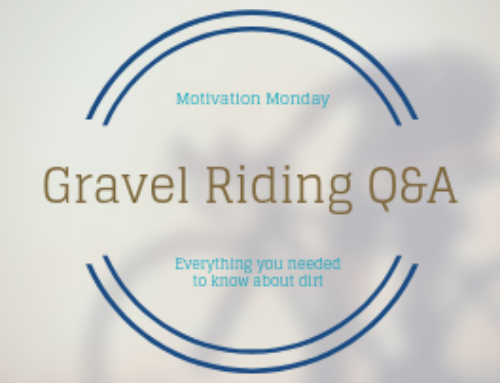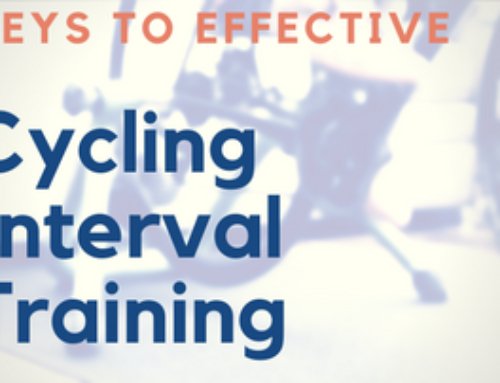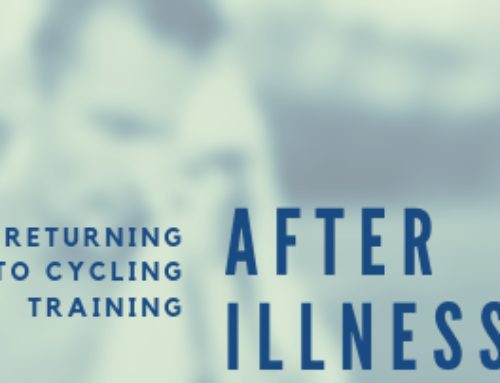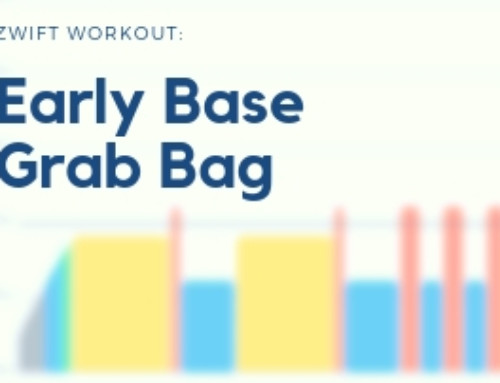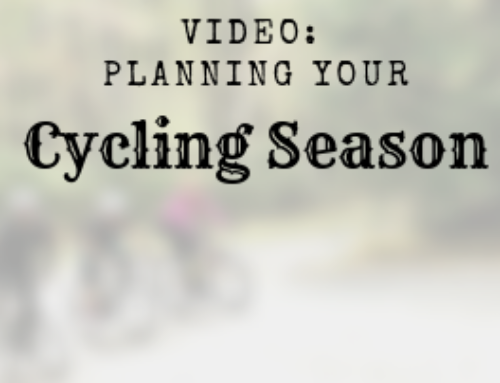The time trial is an integral part of racing a bicycle. It's the race of truth, the race against the clock and one of the truest tests of who is a stronger cyclist. To ride a time trial efficiently is an amazing skill and watching a well executed time trial is a beautiful thing indeed. With the racing season in full swing, I've been getting a lot of questions from athletes about time trial training and racing tips.
In this episode of the Tailwind Coaching Podcast, I'll explain some of the nuances of time trialing and give you the tips you need to race a better time trial. I'll cover the key aspects of a time trial training plan and how to squeeze more fitness out of your body. You'll also get some of my favorite tips, tricks, and marginal gains to help you ride stronger.
So if you're ready to turn the pedals in anger, click through the jump to listen to my best time trial training and racing tips!
Podcast: Play in new window | Download (Duration: 45:31 — 33.6MB)
What Is A Time Trial
A time trial is a race against the clock. You race solo, starting at a set time and with set intervals in between each of the racers. The idea here is the fastest time over the course wins. There's no drafting, no pack riding, and no help. It's just you against the clock.
There are plenty of other rules too. For example, those racing “non time trial” or “Eddy Class” are restricted to skinsuits, aero helmets, and deep section wheels. (Eddy is named for Eddy Merckx, who raced all his TTs on a regular road bike.) No TT bikes, solid disc wheels or tri-spoke wheels are allowed. This helps level the playing field and makes the non time trial class more about strength and endurance versus who can afford the best gear.
What's In A Time Trial Training Plan
The main goal of a time trial training plan is to raise the aerobic threshold so you can put out more power aerobically. The higher your sustained aerobic power, the faster you'll go over the course. You'll also need a couple of specialized skills in order to be successful racing a TT, which I detailed below.
First, let's talk about FTP. FTP (or Functional Threshold Power) is the maximal amount of power you can put out aerobically for a sustained duration. It is your 1-Hour peak power or as your Critical Power. For a detailed description of functional threshold power, check out my podcast on FTP.
Build your VO2 ceiling, raise your FTP to match
As I talked about in this post, in order for your FTP to grow, you have to give it room to do so. If you want to put out more aerobic power, you need to build your maximal oxygen uptake. That's your VO2 Max. A solid time trial training plan will contain plenty of Zone 5/VO2 max work to build that aerobic capacity. After the VO2 max work is completed, you need to build some aerobic endurance with sweetspot level training, FTP level training and longer duration endurance riding.
These two aspects of a time trial training plan are the keys to getting faster. You'll need a little more than a big aerobic engine to go faster though: you'll have to maintain that power for a long time.
More muscular endurance equals a faster time trial
If you want to be able to ride faster, you have to produce more power. Power is a function of force times velocity (leg speed) so increasing any combination of these will lead to more power. However, if you want to continue pushing big gears fast, you have to have the muscular endurance to do it. Quite simply, the harder you push for longer, the tougher it is to keep it up. Your muscles just don't have the fatigue resistance to handle the workload you're putting on them.
Building muscular endurance is one of the keys to time trial training. If you fatigue before the end of your effort, you'll lose massive time. Try adding a couple days of 2×20 minutes at 70RPM, high-tension intervals to your program.
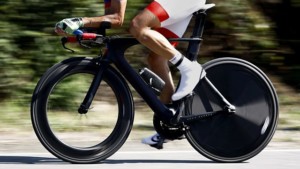 Spin faster to ride faster
Spin faster to ride faster
Neuromuscular coordination is half of the power equation. How? Velocity is directly equal to your ability to spin the cranks quickly, and that involves an incredible amount of coordination between your brain and your legs. For each pedal stroke, there's a carefully orchestrated combination of muscle contractions that help push the bike forward. The more coordinated these contractions are (and the more coordinated the individual fiber twitches are) the more efficient your pedal stroke. This means less energy is lost as heat and more can be focused on pushing the pedals.
To improve your neuromuscular coordination and efficiency, add some leg speed drills to your sweetspot and aerobic training days. Adding intervals like superspins, spinups, and single leg drills will create the necessary improvements in coordination. You'll be more efficient which will translate into increased speed during your time trial effort.
Practice singlespeed training
A while back I created a post detailing the concept of a singlespeed workout. In it, I described the concept of how mimicking a singlespeed can help improve your ability to adapt to changing terrain. In case you haven't read it before or want to implement it right now, here are the basics:
- Start in a gear that allows you to pedal comfortably at your sweetspot or FTP level intensity. Your cadence should be what's comfortable for you.
- Stay in the same gear throughout the entire interval.
- Change your cadence and the amount of force in the pedals based on the terrain.
By adding these kinds of workouts to your time trial training plan, you can get a jump on race type efforts. You'll learn how to handle changes in terrain, cadence, speed, and pace. You'll also get a great over/under type of workout that will train your body to go into the red and recover at threshold.
Time trial training benchmarks
Along with your functional threshold power, there are another couple benchmarks to look at when it comes to time trial training. In order to get an idea of your efficiency and aero capacity, sometimes it's important to do a “10-mile test.” This 10-mile test is a great way to determine if you're applying your power effectively. A good benchmark for a 10-mile flat time trial would be around 25 minutes. This equates to around 24ish MPH.
In addition to learning where you're at in terms of speed, you can also use that 10-mile loop to test new aero enhancements. By riding at a similar power and evaluating your speed, aerobic decoupling, and a few other metrics, you can determine if changes in position have an aero (or efficiency) effect.
When a time trial is a hill climb, all bets are off. You'll be using FTP (and sometimes VO2 max) as benchmarks for hill climb TT performance. I'd suggest riding the TT course before you actually race it to get an idea of where to push and what your pacing should be. Looking at your power to weight ratio can give you some indication of how you'll perform on any given uphill TT effort.
Riding a Time Trial Effectively
When riding a time trial, there are a couple ways to ensure you can put out the best performance possible. By using these tips, you can add a few seconds to your time and possibly jump a couple of spots.
Pre-ride your course
One of the most important ways to improve your time on a time trial course is to pre-ride the course. Knowing exactly what you're about to ride into is a key aspect of optimizing your performance. Knowing where to push, where to back off and when corners are coming prevent any surprises from catching you off guard.
You'll also want to know where you'll have to watch your pacing. In flat open sections, you may find wind in your face that will slow you considerably. It's also key to know about hazards in the road such as potholes, rough pavement or changing shoulder widths. You don't want to get caught being pushed into a lane of traffic because you tried to pass someone at the wrong time.
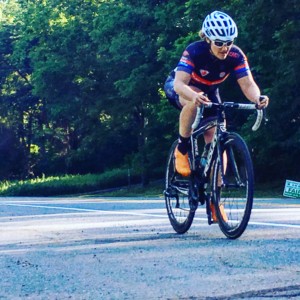 Pacing is key to a peak performance
Pacing is key to a peak performance
Riding a time trial is all about pacing. Keeping your engine just “on boil” will give you the best combination of efficiency and speed. You'll have enough capacity to use your anaerobic capacity and recover at threshold, which allows you to roll over climbs and then recover without losing speed.
If you get the pacing wrong, you'll end up dying closer to the end of the time trial. Ideally, a TT effort should be a negative split, which means you are faster over the second half than the first. By settling into a threshold pace for the first half, you save a little bit to increase your average power by a couple percentage points over the last half.
It's worth pointing out that screwing up your pacing is guaranteed to ruin your performance. Be very aware of pacing and how it applies to the particular course.
Conserve speed and energy as much as possible
By racing smart, conserving speed and using energy where you gain the most out of it, you can improve your performance significantly.
Conserving speed is an easy task. Use techniques like rolling climbs to conserve the speed you've built up and gain precious seconds here and there. You can still recover on the backside of a climb if you've built up a good head of steam over the top.
Knowing when to apply power and when to back off is another key to conserving your limited energy stores. While you should be constantly around your threshold, there are a few instances where pushing or backing down can be beneficial. As the road rises in front of you, adding power will pay big dividends. For example, if you're adding 10% to your power output and you're going 10 MPH uphill, you may be adding 1-2 MPH (10-20%) to your speed. Adding 10% to your power downhill at 20 MPH may add 1-2 MPH or only 5-10% to your speed. That increase in power output nets bigger dividends on a climb than on a descent.
Knowing where you can add small increases in power like that can mean the difference between a podium and a poor showing.
Time Trial Tips and Marginal Gains
If you want to get the absolute most out of your time trial events, I've got a couple of tips and tricks to help you gain a little edge over your competition.
Aero everything matters
It can't be understated how important aero gains can be. Specialized proved that shaving your legs can save you between 50 and 82 seconds over 40 kilometers. That's the difference between a win and mid pack.
With that in mind, try to add anything aero that your category allows. A skinsuit that's properly fitting can shave a bunch of time off your ride. After that, look to smaller gains like an aero helmet, aero booties, and gloves. When you've exhausted all the options, you can start looking into the high dollar items like wheels and frames. Just keep in mind that your racing category may have special restrictions on what you can or can't use.
For a couple of additional watts of savings, you can wax your chain and Pledge (furniture polish) your frame. Those will help reduce a couple of watts of drag and allow you to put that power to the pavement.
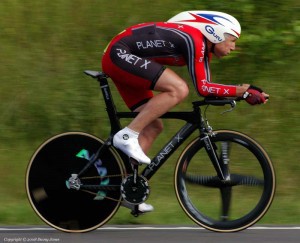
Get low and stay aero
If cheating the wind is your goal, getting comfortable in an aero position is a must. The less frontal area you present to the wind, the faster you'll go and the better time you'll have.
The biggest problem with this position is most cyclists don't train in it often. They utilize the drops only when descending for long periods of time and aren't comfortable riding in them or producing power in them. In fact, in many cases, cyclists produce LESS power in the drops, only because they're not used to riding in that position.
Since you're doing time trial training anyway, it makes sense to do some of your muscular endurance of functional threshold power intervals in the drops. You'll learn how to get comfortable in that position and how to produce power efficiently, both of which will pay big dividends come race day.
Another simple tip that has to do with positioning: don't fight a headwind. You will lose speed to a headwind. Pushing through at a constant speed will ramp up your power output and prematurely fatigue you. Make smart choices with wind direction and don't be afraid to concede a few seconds in a headwind. By maintaining an even pace, you'll prevent minutes of loss if you blow up late in the effort.
Be adaptable on race day
Even the best-laid plans can go awry at the drop of a hat. You need to be adaptable on race day if you want to taste sweet success on race day. Be prepared to make last-minute adjustments to your equipment, plan, and expectations based on how the day unfolds.
A quick note on equipment: always bring a couple of options for wheels and cassettes. With time trials, even though the deeper, more aerodynamic wheels are a better choice for the aero benefits, they suffer mightily in cross-winds. If you're seeing significant cross-winds on race day, be prepared to switch to a shallower wheel. The loss of aerodynamics will be overshadowed by the excess energy you'll expend trying to keep the bike in a straight line. All those side-to-side motions, the nervousness of cross winds and the mental awareness you'll need can contribute to energy loss during your ride.
For cassettes, occasionally you'll see that your legs aren't as great as you hoped and having a different option for gears can give you a little bit of comfort. This is especially true if you're riding an uphill time trial where gearing becomes much more important.
With these tips, you should be able to jumpstart your time trial abilities and race to your fullest potential in no time! Remember, if you love what you hear, head on over to iTunes and give the podcast 5 stars. Don't forget my podcast discount code to take 10% off any of the training programs in my online training plan store!

